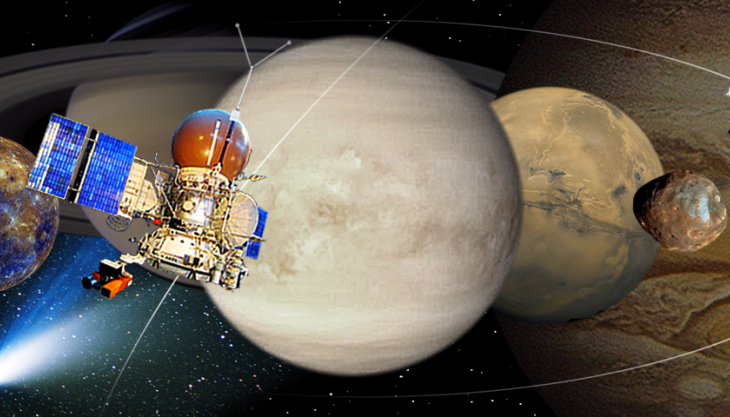Planetary Physics

Head of the department
corresponding member of the Russian Academy of Sciences
Dr.Sc. Oleg I. Korablev
Labs
- Spectroscopy of Planetary Atmospheres. Head: Dr.Sc. Lyudmila V. ZASOVA
- Direct Physical and Chemical Studies of Planets. Head: Ph.D. Mikhail V. GERASIMOV
- Studies of Planetary Atmospheres with Autonomous Instrumental Sets
- Interplanetary Environment. Head: Dr.Sc. Vladislav V. IZMODENOV
- Planetary Astronomy. Head: Dr.Sc. Alexander V. TAVROV
- Experimental Spectroscopy. Head: Ph.D. Anna A. FEDOROVA
- Planet Spectrometry and Meteorology. Head: Ph.D. Yuri S. DOBROLENSKY
- Sector for Atmospheric and Climate Dynamics. Head: Dr.Sc. Arakel S. PETROSYAN
- Group for Operational Support
Новости
Head of the department
corresponding member of the Russian Academy of Sciences
Dr.Sc. Oleg I. Korablev
Labs
- Spectroscopy of Planetary Atmospheres. Head: Dr.Sc. Lyudmila V. ZASOVA
- Direct Physical and Chemical Studies of Planets. Head: Ph.D. Mikhail V. GERASIMOV
- Studies of Planetary Atmospheres with Autonomous Instrumental Sets
- Interplanetary Environment. Head: Dr.Sc. Vladislav V. IZMODENOV
- Planetary Astronomy. Head: Dr.Sc. Alexander V. TAVROV
- Experimental Spectroscopy. Head: Ph.D. Anna A. FEDOROVA
- Planet Spectrometry and Meteorology. Head: Ph.D. Yuri S. DOBROLENSKY
- Sector for Atmospheric and Climate Dynamics. Head: Dr.Sc. Arakel S. PETROSYAN
- Group for Operational Support
Themes
- structure and composition of planetary atmospheres;
- radiative transfer in planetary atmospheres;
- atmospheres and climate dynamics;
- nonlinear wave processes, turbulence in planetary atmospheres;
- chemical composition of planets’ and satellites’ solid substance by direct and remote methods;
- dust dynamics on planets and satellites;
- experimental and model studies of high-speed shock-evaporation processes during crater formation;
- the global structure of the heliosphere and interaction of the solar wind with the interstellar medium;
- interplanetary environment;
- statistical studies of the distribution of exoplanets;
- stellar coronagraphy for obtaining direct images of exoplanets;
- spectrometers development from ultraviolet to thermal infrared ranges to study planetary atmospheres and surfaces;
- diode laser spectroscopy for planetary research;
- mass spectrometry;
- meteorological complexes;
- instrument engineering & planetary projects’ management.
In general
The studies of other planets and small bodies of the Solar System in IKI had been first assigned to the Department of Astrophysics for almost ten years and turned into an independent direction only in 1973-74. By that time, it became clear that planetary exploration is an independent area of space science that requires its own tools, approaches, and methods. The spacecraft gave researchers an opportunity to study other planets of the Solar System not only from afar with the help of telescopes, but also from much closer distances: from orbits around celestial bodies, during the passage near them and, of course, directly from the surface. Thus began the era of planetary experiments in situ — "at the location" (Lat.).
Vasily I. Moroz (1931-2004) was the first head of the Department, the founder of the scientific school and the “father” of infrared spectrometry in Russia. An IR spectrometer in orbit is an effective instrument for planetary studies, as the spectrum of a planet contains characteristic bands of gases present in the atmosphere, information about the vertical profile of its temperature, the temperature and composition of the surface, the composition and distribution of the aerosol component. This information reveals the conditions on the planet, in particular its dynamics, and it’s used to calculate atmospheric models.
The Department’s scientists participated in and managed many projects and experiments of the Soviet and Russian planetary exploration programs. Among them are Veneras 4 to 16 (1967-83) and Vega projects (1984), Marses 3 to 6 (1971-73) and Phobos projects (1988), Mars-96 (1996) and Phobos Sample Return (2011).
Today, the Department unites theorists, experimentalists, and engineers in the field of physical studies of the atmosphere and surface of other planets of the Solar System. In the first place, there are studies of Mars and Venus, the two closest planetary neighbors of the Earth, which have historically received enhanced attention from space researchers. The Department's works are also devoted to Mercury, the giant planets Jupiter and Saturn and small bodies: satellites of planets, comets and asteroids. A new direction is the study of exoplanets in other stellar systems.
The Department is engaged with instrument design and development for all future Russian planetary projects, the first of which are Russian-European ExoMars project and Lunas 25 to 27. It is also involved in many foreign missions, providing Russian contribution to scientific payload: Mars Express, Venus Express, BepiColombo, Shukraayan, JUICE, etc.
On August 20, 2007, by the decision of the working group on the nomenclature of the planetary system at the International Astronomical Union, the name «Moroz» was officially assigned to one of the Mars craters. The Moroz crater (3 km in diameter) is located on an ancient hill of Mars (12 Center Latitude -23.77 °, Center Longitude 339.43 °) near the landing site of the Soviet Mars-6 spacecraft.
